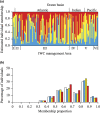Towards population-level conservation in the critically endangered Antarctic blue whale: the number and distribution of their populations
- PMID: 26951747
- PMCID: PMC4782106
- DOI: 10.1038/srep22291
Towards population-level conservation in the critically endangered Antarctic blue whale: the number and distribution of their populations
Abstract
Population-level conservation is required to prevent biodiversity loss within a species, but it first necessitates determining the number and distribution of populations. Many whale populations are still depleted due to 20th century whaling. Whales are one of the most logistically difficult and expensive animals to study because of their mobility, pelagic lifestyle and often remote habitat. We tackle the question of population structure in the Antarctic blue whale (Balaenoptera musculus intermedia) - a critically endangered subspecies and the largest extant animal - by capitalizing on the largest genetic dataset to date for Antarctic blue whales. We found evidence of three populations that are sympatric in the Antarctic feeding grounds and likely occupy separate breeding grounds. Our study adds to knowledge of population structure in the Antarctic blue whale. Future research should invest in locating the breeding grounds and migratory routes of Antarctic blue whales through satellite telemetry to confirm their population structure and allow population-level conservation.
Figures



References
-
- Purvis A. & Hector A. Getting the measure of biodiversity. Nature 405, 212–219 (2000). - PubMed
-
- Stockwell C. A., Hendry A. P. & Kinnison M. T. Contemporary evolution meets conservation biology. Trends Ecol. Evol. 18, 94–101 (2003).
-
- Pressey R. L., Cabeza M., Watts M. E., Cowling R. M. & Wilson K. A. Conservation planning in a changing world. Trends Ecol. Evol. 22, 583–592 (2007). - PubMed
-
- Garner A., Rachlow J. L. & Hicks J. F. Patterns of genetic diversity and its loss in mammalian populations. Conserv. Biol. 19, 1215–1221 (2005).
-
- Clapham P. J., Young S. B. & Brownell R. L. Jr. Baleen whales: conservation issues and the status of the most endangered populations. Mamm. Rev. 29, 35–60 (1999).
Publication types
MeSH terms
LinkOut - more resources
Full Text Sources
Other Literature Sources

